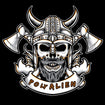
Since Viking times, the Nordic people have had a long tradition of celebrating winter festivals. One of the festivals that has survived to this day is called "Yule" or "Yuletide, Yulefest". The dictionary explains it as "Christmas; the Christmas season", but the concept is actually a blend of North Germanic tradition and Christian culture.
FACTS:
Q: Are the Germanic tribes Vikings?
A: No, only the North Germanic or “Norse” peoples, i.e. the peoples who became Swedes, Norwegians, Danes and Icelanders.
Yule, also known as Yuletide or Yulefest, is a traditional winter festival of the ancient Norse. In Latin, it is written ġēol (or ġēohol) or ġēola (or ġēoli).

There are different opinions about the origin of Yule. There is an argument in the literature that is related to another traditional German festival Mōdraniht (Modranect in English). Mōdraniht means "Night of the Mothers". Bede wrote the following in his De temporum ratione:
“Incipiebant autem annum ab octavo Calendarum Januariarum die, ubi nunc natale Domini celebramus. Et ipsam noctem nunc nobis sacrosa-nctam, tunc gentili vocabulo Modranicht, id est, matrum noctem appellabant: ob causam et suspicamur ceremoniarum, quas in ea pervigiles agebant. ”
According to the ancient tradition of the Vikings, on the night of December 24th, people will pay tribute to the eldest mothers in the tribe and the ancestors and mythology goddesses who have passed away. This includes both Frigg and Freya in Norse mythology in some stories the two often refer to the same person), and the three goddesses Matres (or Matronae) influenced by Roman culture.

The Saga of Hákon the Good relates that King Hákon I of Norway, who ruled from 934-961, re-dated Yule to coincide with Christmas in order to promote the Christianisation of Norway. According to the Saga, Hákon was already a devout Christian when he arrived in Norway, but the native inhabitants of Norway still clung to their pagan traditions. Haakon had to hide his Christianity for a while in order to enlist the help of the local 'big chiefs'. He planned to spread the gospel to the natives once he had established his power in the country. So Haakon passed a law declaring that the celebration of Yule would coincide with the celebration of the birth of Christ.
The overlap in content between Yule and Christmas is thus gradually established. So it is not difficult to look up "Yule" or "Yuletide" in the dictionary and give the meaning "n. Christmas; the Christmas season". Today, Christmas in Europe retains many traces of the culture of the Viking Age.
Fun Facts About Viking Yule
Yuleblót - The Christmas Goat

The Christmas goat (Yule Goat or Yulbukk) is a popular Christmas tradition in Sweden. According to the Poetic Edda, compiled in the 13th century, Thor had a chariot drawn by two goats (Tanngrisnir or Tanngnjóstr). As well as pulling the chariot for Thor, one of the important tasks of the two goats was to serve as food for Thor. After Thor had slaughtered and eaten them, he revived the two goats with Mjölnir.
Niðsi - The Nisse

The Nisse (or Tomte) is another Christmas tradition that arose in conjunction with the goats of Thor. In Norse folklore, the Nisse is often depicted as a small, elderly-faced, bearded humanoid creature. People living in Scandinavia believe that the tomtes are the spirits of their fabled ancestors and that they live in farm burial mounds. The Nisse is said to protect homes and farms from invasion and are also seen as helpers in the winter months when household chores are being handled. The best way to please them is the milk muesli with butter. So people would leave the treats on their doorstep on the evening of 24 December, and the next day the Nisse would return the favor with a gift.
The Viking Santa

The Vikings had a Santa Claus of their own. A man dressed up as Winter old man. Vikings always welcomed old people into their homes and joined them at banquets. He travelled around in a hooded cloak. Sometimes he walks, sometimes he rides a horse. Many theorized that Santa was actually Odin and that the horse he rode was Sleipnir.
Looking for some Viking Design Clothing or Nordic Accessories? Please visit our website for more.

